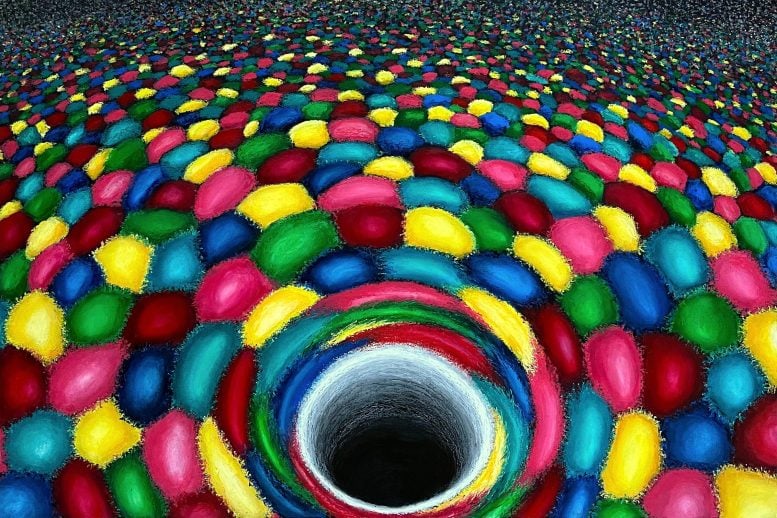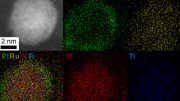
Depiction of a primordial black hole forming amid a sea of hot, color-charged quarks and gluons, a tiny fraction of a second after the Big Bang. Credit: Kaća Bradonjić
In the first quintillionth of a second, the universe may have sprouted microscopic black holes with enormous amounts of nuclear charge, according to MIT physicists.
MIT researchers propose that primordial black holes, possibly a form of dark matter, could have been formed in the first moments after the Big Bang and carried high levels of a nuclear property known as color charge. These super-charged black holes, despite their brief existence, may have impacted the early universe’s cosmology and could explain some astronomical phenomena observed today.
Dark Matter and Primordial Black Holes
For every kilogram of matter that we can see — from the phone in your hand to distant stars and galaxies — there are 5 kilograms of invisible matter that permeate our surroundings. This “dark matter” is a mysterious entity that evades all forms of direct observation yet makes its presence felt through its invisible pull on visible objects.
Fifty years ago, physicist Stephen Hawking proposed an idea for what dark matter might be: a population of black holes, which might have formed very soon after the Big Bang. Such “primordial” black holes would not have been the goliaths that we detect today, but rather microscopic regions of ultradense matter that would have formed in the first quintillionth of a second following the Big Bang and then collapsed and scattered across the cosmos, tugging on surrounding space-time in ways that could explain the dark matter that we know today.
Uncovering Super-Charged Black Holes
Now, MIT physicists have found that this primordial process also would have produced some unexpected companions: even smaller black holes with unprecedented amounts of a nuclear-physics property known as “color charge.”
These smallest, “super-charged” black holes would have been an entirely new state of matter, which likely evaporated a fraction of a second after they spawned. Yet they could still have influenced a key cosmological transition: the time when the first atomic nuclei were forged. The physicists postulate that the color-charged black holes could have affected the balance of fusing nuclei, in a way that astronomers might someday detect with future measurements. Such an observation would point convincingly to primordial black holes as the root of all dark matter today.
“Even though these short-lived, exotic creatures are not around today, they could have affected cosmic history in ways that could show up in subtle signals today,” says David Kaiser, the Germeshausen Professor of the History of Science and professor of physics at MIT. “Within the idea that all dark matter could be accounted for by black holes, this gives us new things to look for.”
Kaiser and his co-author, MIT graduate student Elba Alonso-Monsalve, have published their study on June 6 in the journal Physical Review Letters.
A Time Before Stars
The black holes that we know and detect today are the product of stellar collapse, when the center of a massive star caves in on itself to form a region so dense that it can bend space-time such that anything — even light — gets trapped within. Such “astrophysical” black holes can be anywhere from a few times as massive as the sun to many billions of times more massive.
“Primordial” black holes, in contrast, can be much smaller and are thought to have formed in a time before stars. Before the universe had even cooked up the basic elements, let alone stars, scientists believe that pockets of ultradense, primordial matter could have accumulated and collapsed to form microscopic black holes that could have been so dense as to squeeze the mass of an asteroid into a region as small as a single atom. The gravitational pull from these tiny, invisible objects scattered throughout the universe could explain all the dark matter that we can’t see today.
If that were the case, then what would these primordial black holes have been made from? That’s the question Kaiser and Alonso-Monsalve took on with their new study.
“People have studied what the distribution of black hole masses would be during this early-universe production but never tied it to what kinds of stuff would have fallen into those black holes at the time when they were forming,” Kaiser explains.
Super-Charged Rhinos
The MIT physicists looked first through existing theories for the likely distribution of black hole masses as they were first forming in the early universe.
“Our realization was, there’s a direct correlation between when a primordial black hole forms and what mass it forms with,” Alonso-Monsalve says. “And that window of time is absurdly early.”
She and Kaiser calculated that primordial black holes must have formed within the first quintillionth of a second following the Big Bang. This flash of time would have produced “typical” microscopic black holes that were as massive as an asteroid and as small as an atom. It would have also yielded a small fraction of exponentially smaller black holes, with the mass of a rhino and a size much smaller than a single proton.
What would these primordial black holes have been made from? For that, they looked to studies exploring the composition of the early universe, and specifically, to the theory of quantum chromodynamics (QCD) — the study of how quarks and gluons interact.
Quantum Dynamics and Black Hole Formation
Quarks and gluons are the fundamental building blocks of protons and neutrons — elementary particles that combined to forge the basic elements of the periodic table. Immediately following the Big Bang, physicists estimate, based on QCD, that the universe was an immensely hot plasma of quarks and gluons that then quickly cooled and combined to produce protons and neutrons.
The researchers found that, within the first quintillionth of a second, the universe would still have been a soup of free quarks and gluons that had yet to combine. Any black holes that formed in this time would have swallowed up the untethered particles, along with an exotic property known as “color charge” — a state of charge that only uncombined quarks and gluons carry.
The Role of Color Charge in Black Hole Dynamics
“Once we figured out that these black holes form in a quark-gluon plasma, the most important thing we had to figure out was, how much color charge is contained in the blob of matter that will end up in a primordial black hole?” Alonso-Monsalve says.
Using QCD theory, they worked out the distribution of color charge that should have existed throughout the hot, early plasma. Then they compared that to the size of a region that would collapse to form a black hole in the first quintillionth of a second. It turns out there wouldn’t have been much color charge in most typical black holes at the time, as they would have formed by absorbing a huge number of regions that had a mix of charges, which would have ultimately added up to a “neutral” charge.
Conclusion and Future Implications
But the smallest black holes would have been packed with color charge. In fact, they would have contained the maximum amount of any type of charge allowed for a black hole, according to the fundamental laws of physics. Whereas such “extremal” black holes have been hypothesized for decades, until now no one had discovered a realistic process by which such oddities actually could have formed in our universe.
Professor Bernard Carr of Queen Mary University of London, an expert on the topic of primordial black holes who first worked on the topic with Stephen Hawking, describes the new work as “exciting.” Carr, who was not involved in the study, says the work “shows that there are circumstances in which a tiny fraction of the early universe can go into objects with an enormous amount of color charge (at least for a while), exponentially greater than what has been identified in previous studies of QCD.”
The super-charged black holes would have quickly evaporated, but possibly only after the time when the first atomic nuclei began to form. Scientists estimate that this process started around one second after the Big Bang, which would have given extremal black holes plenty of time to disrupt the equilibrium conditions that would have prevailed when the first nuclei began to form. Such disturbances could potentially affect how those earliest nuclei formed, in ways that might some day be observed.
“These objects might have left some exciting observational imprints,” Alonso-Monsalve muses. “They could have changed the balance of this versus that, and that’s the kind of thing that one can begin to wonder about.”
Reference: “Primordial Black Holes with QCD Color Charge” by Elba Alonso-Monsalve and David I. Kaiser, 6 June 2024, Physical Review Letters.
DOI: 10.1103/PhysRevLett.132.231402
This research was supported, in part, by the U.S. Department of Energy. Alonso-Monsalve is also supported by a fellowship from the MIT Department of Physics.









I can see the connection this article explains, a theory of mine is close to the same but in a different and opposite direction of tension, expansion of the universe the pull of color charge could create a tension. The theory of micro super charged black holes has credibility but one part of the calculation is missing, what lies out side the expanding universe this may have benefits to explain the formation of the micro holes being pulled to existence then the creation of matter for expansion, and the other side encircling out side the universe. the pull of cosmic tension expansion a pull that is constant, we can see this in the new WEB telescope and a super massive black hole close to the beginning of time. almost shaping the universe as a donut figure.
Do you realize that the paper describes a testable scientific theory – they even suggest how to start figure out tests – while your personal opinion ‘theory’ has nothing to do with science!?
Hello, I enjoyed your article about primordial black holes. However, the constant intrusion of the ads made the content difficult to enjoy. Especially that specific subject matter.
Time is Time you can go back and forward time management time machine is now
I had suggested on social media that the two topologies of spatial domain boundary defect monopoles ought to be considered as prime candidates for dark matter and dark energy. One topology acts similar to gravity wells, the other the total inverse (which often gets misconstrued as to the nature of that, as with dark energy, these would push things away faster the further away they are). These monopoles were also left over from the early universe.
So,the hypothesis is based on the Dynamic Big Bang.But,works are needed to reach the truth.